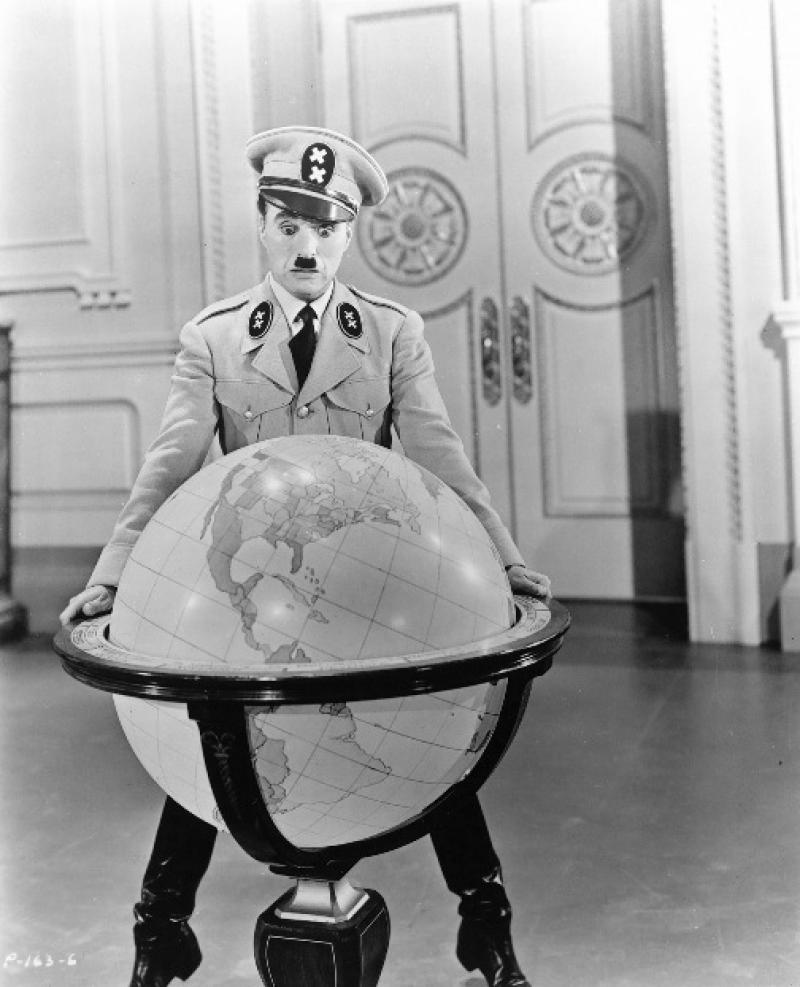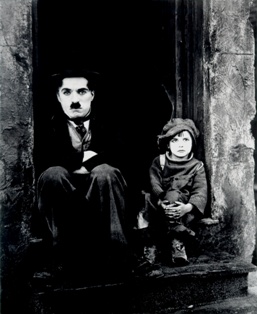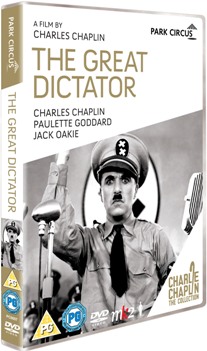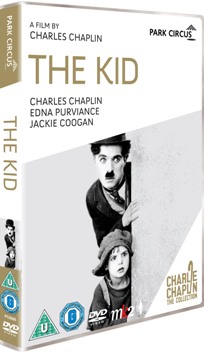DVD: The Kid/ The Great Dictator | reviews, news & interviews
DVD: The Kid/ The Great Dictator
DVD: The Kid/ The Great Dictator
Compare and contrast two Chaplin classics

There was a celebrated two-word come-on to 1930s movie-goers. “Garbo Laughs!” was a poster strapline calculated to seduce fans of the mournful Swedish star to Ninotchka, in which her character had an unwonted fit of the giggles. Audiences were rather more conflicted when another cinematic embargo was ended. In The Great Dictator, Chaplin talks.
He took his time: 1940 was 13 years after The Jazz Singer. The greatest star of the silent age chose to stick with what he knew, and cast Luddite aspersions on the new-fangled talkies. It was the rise of Nazism which persuaded him to succumb fully to sound. To mark the event, he billed himself as Charles Chaplin rather than the diminutive by which the globe knew him. Not that he erased all vestiges of the Tramp, so adored in films such as The Kid (1921).
The Great Dictator and The Kid are both being released in crisp new digitised versions, as well as on Blu-ray, which affords a chance to compare and contrast the two Chaplins: the beloved circus sentimentalist on the one hand, and the fearless activist on the other, whose political affiliations proved so distasteful to McCarthyite America.
 Not that one film entirely embodies the one point of view to the exclusion of the other. The Kid was Chaplin’s effort to fold social action into slapstick comedy – “a picture with a smile,” as he described it, “and, perhaps, a tear.” The Tramp finds himself accidentally adopting an orphan baby who has been abandoned by his destitute mother. The squalor in which we find them five years later constituted Chaplin’s critique of society’s contempt for the poor. It was fine for a Tramp to shuffle comedically through life with no available funds - not for a cute little scallywag to live in rags too. And make no mistake, Jackie Coogan as the Kid (pictured above right) gave a captivating performance. As the big screen's original child star, he no doubt contributed to an unprecedented commercial success for Chaplin. In one dream sequence, The Kid also parades Chaplin’s less heralded gift for surreal experimentation.
Not that one film entirely embodies the one point of view to the exclusion of the other. The Kid was Chaplin’s effort to fold social action into slapstick comedy – “a picture with a smile,” as he described it, “and, perhaps, a tear.” The Tramp finds himself accidentally adopting an orphan baby who has been abandoned by his destitute mother. The squalor in which we find them five years later constituted Chaplin’s critique of society’s contempt for the poor. It was fine for a Tramp to shuffle comedically through life with no available funds - not for a cute little scallywag to live in rags too. And make no mistake, Jackie Coogan as the Kid (pictured above right) gave a captivating performance. As the big screen's original child star, he no doubt contributed to an unprecedented commercial success for Chaplin. In one dream sequence, The Kid also parades Chaplin’s less heralded gift for surreal experimentation.
19 years on, in The Great Dictator, Chaplin had by no means abandoned his zest for slapstick – for chucking messy food around and nimbly ducking punches thrown by big ugly lunks. He even attempted a half-hearted repeat of the most skilful sequence in The Kid – the rooftop chase in which he retrieves the kid abducted by the authorities. But these familiar tropes were put in the service of a pioneering satire of National Socialism. No Hollywood studio had dared to lampoon Hitler even after seven years in power, so it fell to the financially independent Chaplin to wield an endearingly blunt mallet.
 It was a fitting way to break his silence. It’s set between the two world wars, “an interim in which Insanity cut loose, Liberty took a nose dive, and Humanity was kicked around somewhat”. Chaplin, identified the world over by his toothbrush moustache, took to the role of his doppelgänger “Hynkel” with wonderful aplomb (the film also had parts for "Herring" and "Garbitsch", pr. Garbage, and a buffoonish dictator called Napoloni). In the film’s most outlandish (and famous) sequences, Hynkel spouts rasping, sclerotic gobbets of Teutonic-sounding gibberish to vast rallies, or to secretaries taking dictation.
It was a fitting way to break his silence. It’s set between the two world wars, “an interim in which Insanity cut loose, Liberty took a nose dive, and Humanity was kicked around somewhat”. Chaplin, identified the world over by his toothbrush moustache, took to the role of his doppelgänger “Hynkel” with wonderful aplomb (the film also had parts for "Herring" and "Garbitsch", pr. Garbage, and a buffoonish dictator called Napoloni). In the film’s most outlandish (and famous) sequences, Hynkel spouts rasping, sclerotic gobbets of Teutonic-sounding gibberish to vast rallies, or to secretaries taking dictation.
But when acting in his own language, it’s clear why Chaplin eschewed sound for so long: like Lina Lamont in Singin’ in the Rain, he didn’t quite have the chops for it. This is clearest in the subplot featuring a Jewish barber, also played by Chaplin, whom the regime confines to a concentration camp. His spoken voice is fluting, polite and generally at odds with the eccentricities of his ungovernable body.
 Plot-wise the entire film is not entirely satisfactory – but then as The Kid amply proves, plot is not what you go to Chaplin for. What’s interesting, also slightly uncomfortable, is to watch the unresolved conflict between long-ingrained instincts to communicate to audiences through his physicality, and the requirement to sell a joke vocally. In that sense, The Great Dictator is a work-in-progress, a laboratory full of experiments, some of them failures. All of the most satisfactory gags are visual, many pulled off with as much dazzling invention as anything in The Kid.
Plot-wise the entire film is not entirely satisfactory – but then as The Kid amply proves, plot is not what you go to Chaplin for. What’s interesting, also slightly uncomfortable, is to watch the unresolved conflict between long-ingrained instincts to communicate to audiences through his physicality, and the requirement to sell a joke vocally. In that sense, The Great Dictator is a work-in-progress, a laboratory full of experiments, some of them failures. All of the most satisfactory gags are visual, many pulled off with as much dazzling invention as anything in The Kid.
The most beautiful finds Hynkel in a silent pas de deux with a blow-up globe - his dream being to conquer the real thing. Even if its intention is to make Hynkel – and by extension Hitler – look ridiculous, Chaplin cannot quite suppress the intoxicating grace of his movements. Hitler is said to have watched the film twice. No wonder.
- Find The Kid and The Great Dictator on Amazon
Share this article
The future of Arts Journalism
You can stop theartsdesk.com closing!
We urgently need financing to survive. Our fundraising drive has thus far raised £49,000 but we need to reach £100,000 or we will be forced to close. Please contribute here: https://gofund.me/c3f6033d
And if you can forward this information to anyone who might assist, we’d be grateful.

Subscribe to theartsdesk.com
Thank you for continuing to read our work on theartsdesk.com. For unlimited access to every article in its entirety, including our archive of more than 15,000 pieces, we're asking for £5 per month or £40 per year. We feel it's a very good deal, and hope you do too.
To take a subscription now simply click here.
And if you're looking for that extra gift for a friend or family member, why not treat them to a theartsdesk.com gift subscription?
more Film
 Blu-Ray: The Man in the White Suit
Ealing Studios' prescient black comedy, as sharp as ever
Blu-Ray: The Man in the White Suit
Ealing Studios' prescient black comedy, as sharp as ever
 The Woman in Cabin 10 review - Scandi noir meets Agatha Christie on a superyacht
Reason goes overboard on a seagoing mystery thriller
The Woman in Cabin 10 review - Scandi noir meets Agatha Christie on a superyacht
Reason goes overboard on a seagoing mystery thriller
 London Film Festival 2025 - crime, punishment, pop stars and shrinks
Daniel Craig investigates, Jodie Foster speaks French and Colin Farrell has a gambling habit
London Film Festival 2025 - crime, punishment, pop stars and shrinks
Daniel Craig investigates, Jodie Foster speaks French and Colin Farrell has a gambling habit
 I Swear review - taking stock of Tourette's
A sharp and moving tale of cuss-words and tics
I Swear review - taking stock of Tourette's
A sharp and moving tale of cuss-words and tics
 A House of Dynamite review - the final countdown
Kathryn Bigelow's cautionary tale sets the nuclear clock ticking again
A House of Dynamite review - the final countdown
Kathryn Bigelow's cautionary tale sets the nuclear clock ticking again
 theartsdesk Q&A: Idris Elba on playing a US President faced with a missile crisis in 'A House of Dynamite'
The star talks about Presidential decision-making when millions of lives are imperilled
theartsdesk Q&A: Idris Elba on playing a US President faced with a missile crisis in 'A House of Dynamite'
The star talks about Presidential decision-making when millions of lives are imperilled
 Urchin review - superb homeless drama
Frank Dillane gives a star-making turn in Harris Dickinson’s impressive directorial debut
Urchin review - superb homeless drama
Frank Dillane gives a star-making turn in Harris Dickinson’s impressive directorial debut
 Mr Blake at Your Service review - John Malkovich in unlikely role as an English butler
Weird comedy directed by novelist Gilles Legardinier
Mr Blake at Your Service review - John Malkovich in unlikely role as an English butler
Weird comedy directed by novelist Gilles Legardinier
 Don't Let's Go to the Dogs Tonight review - vivid adaptation of a memoir about a Rhodesian childhood
Embeth Davidtz delivers an impressive directing debut and an exceptional child star
Don't Let's Go to the Dogs Tonight review - vivid adaptation of a memoir about a Rhodesian childhood
Embeth Davidtz delivers an impressive directing debut and an exceptional child star
 One Battle After Another review - Paul Thomas Anderson satirises America's culture wars
Leonardo DiCaprio, Teyana Taylor, and Sean Penn star in a rollercoasting political thriller
One Battle After Another review - Paul Thomas Anderson satirises America's culture wars
Leonardo DiCaprio, Teyana Taylor, and Sean Penn star in a rollercoasting political thriller
 Steve review - educator in crisis
Cillian Murphy excels as a troubled headmaster working with delinquent boys
Steve review - educator in crisis
Cillian Murphy excels as a troubled headmaster working with delinquent boys

Add comment